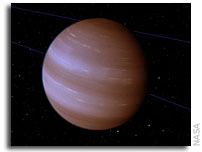Diagnosing Chemical Disequilibrium in Planetary Atmospheres

Chemical disequilibrium has recently become a relevant topic in the study of the atmospheres of of transiting extrasolar planets, brown dwarfs, and directly imaged exoplanets. We present a new way of assessing whether or not a Jovian-like atmosphere is in chemical disequilibrium from observations of detectable or inferred gases such as H$_2$O, CH$_4$, CO, and H$_2$.
Our hypothesis, based on previous kinetic modeling studies, is that cooler atmospheres will show stronger signs of disequilibrium than hotter atmospheres. We verify this with chemistry-transport models and show that planets with temperatures less than $\sim$1200 K are likely to show the strongest signs of disequilibrium due to the vertical quenching of CO, and that our new approach is able to capture this process. We also find that in certain instances a planetary composition may appear in equilibrium when it actually is not due to the degeneracy in the shape of the vertical mixing ratio profiles.
We determine the state of disequilibrium in eight exoplanets using the results from secondary eclipse temperature and abundance retrievals. We find that all of the planets in our sample are consistent with thermochemical equilibrium to within 3-sigma. Future observations are needed to further constrain the abundances in order to definitively identify disequilibrium in exoplanet atmospheres.
A Systematic Retrieval Analysis of Secondary Eclipse Spectra III: Diagnosing Chemical Disequilibrium in Planetary Atmospheres
Michael R Line, Yuk Yung
(Submitted on 25 Sep 2013)
Comments: submitted to ApJ
Subjects: Earth and Planetary Astrophysics (astro-ph.EP)
Cite as: arXiv:1309.6679 [astro-ph.EP]
(or arXiv:1309.6679v1 [astro-ph.EP] for this version)
Submission history
From: Michael Line Mr.
[v1] Wed, 25 Sep 2013 21:49:06 GMT (173kb,D)








